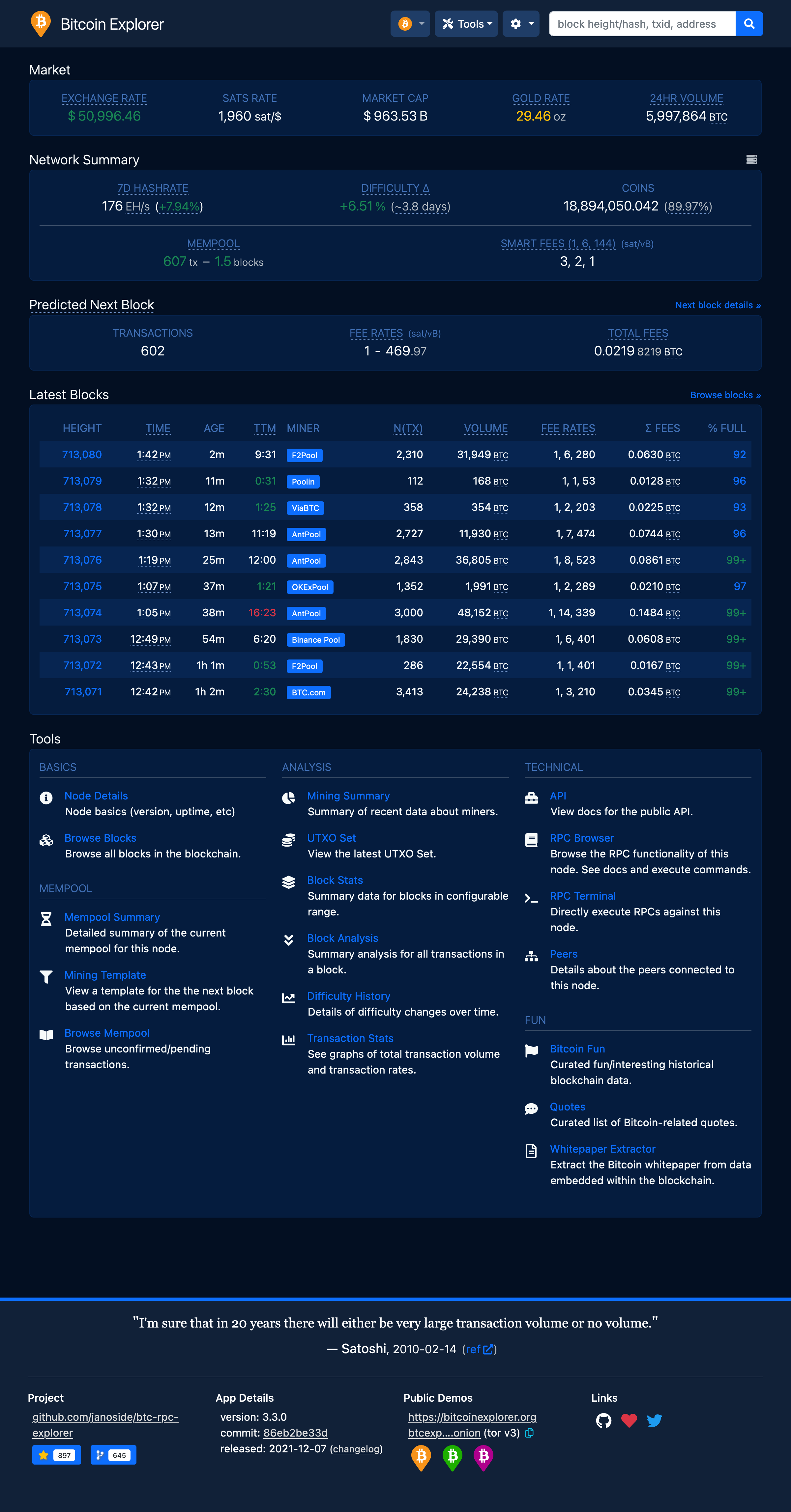BTC RPC Explorer

Simple, database-free Bitcoin blockchain explorer, via RPC to Bitcoin Core.
This is a simple, self-hosted explorer for the Bitcoin blockchain, driven by RPC calls to your own Bitcoin node. It is easy to run and can be connected to other tools (like ElectrumX) to achieve a full-featured explorer.
Whatever reasons one may have for running a full node (trustlessness, technical curiosity, supporting the network, etc) it's helpful to appreciate the "fullness" of your node. With this explorer, you can explore not just the blockchain database, but also explore the functional capabilities of your own node.
Live demo available at: https://explorer.btc21.org
Features
- Network Summary dashboard
- View details of blocks, transactions, and addresses
- Analysis tools for viewing stats on blocks, transactions, and miner activity
- See raw JSON content from bitcoind used to generate most pages
- Search by transaction ID, block hash/height, and address
- Optional transaction history for addresses by querying from ElectrumX, blockchain.com, blockchair.com, or blockcypher.com
- Mempool summary, with fee, size, and age breakdowns
- RPC command browser and terminal
Changelog / Release notes
See CHANGELOG.md.
Getting started
Prerequisites
- Install and run a full, archiving node - instructions. Ensure that your bitcoin node has full transaction indexing enabled (
txindex=1) and the RPC server enabled (server=1). - Synchronize your node with the Bitcoin network (you can use this tool while your node is still sychronizing, but some pages may fail).
- Install a "recent" version of Node.js (8+ recommended).
Install / Run
If you're running on mainnet with the default datadir and port, the default configuration should Just Work. Otherwise, see the Configuration section below.
Install via npm:
npm install -g btc-rpc-explorer
btc-rpc-explorerRun from source:
git clone https://github.com/janoside/btc-rpc-explorercd btc-rpc-explorernpm installnpm start
Using either method (npm install or run from source), after startup open http://127.0.0.1:3002/
Configuration
Configuration options may be set via environment variables or CLI arguments.
Configuration with environment variables
To configure with environment variables, you need to create one of the 2 following files and enter values in it:
~/.config/btc-rpc-explorer.env.envin the working directory for btc-rpc-explorer
In either case, refer to .env-sample for a list of the options and formatting details.
Configuration with CLI args
For configuring with CLI arguments, run btc-rpc-explorer --help for the full list of options. An example execution is:
btc-rpc-explorer --port 8080 --bitcoind-port 18443 --bitcoind-cookie ~/.bitcoin/regtest/.cookieDemo site settings
To match the features visible on the demo site at https://explorer.btc21.org you'll need to set the following non-default configuration values:
BTCEXP_DEMO=true # enables some demo/informational aspects of the site
BTCEXP_NO_RATES=false # enables querying of exchange rate data
BTCEXP_SLOW_DEVICE_MODE=false # enables resource-intensive tasks (UTXO set query, 24hr volume querying) that are inappropriate for "slow" devicesSSO authentication
You can configure SSO authentication similar to what ThunderHub and RTL provide.
To enable it, make sure BTCEXP_BASIC_AUTH_PASSWORD is not set and set BTCEXP_SSO_TOKEN_FILE to point to a file write-accessible by btc-rpc-explorer.
Then to access btc-rpc-explorer, your SSO provider needs to read the token from this file and set it in URL parameter token.
For security reasons the token changes with each login, so the SSO provider needs to read it each time!
After successfull access with the token a cookie is used for authentication, so you don't have to worry about it anymore.
To improve user experience you can set BTCEXP_SSO_LOGIN_REDIRECT_URL to the URL of your SSO provider.
This causes the users to be redirected to login page if not logged in.
Run via Docker
docker build -t btc-rpc-explorer .docker run -it -p 3002:3002 -e BTCEXP_HOST=0.0.0.0 btc-rpc-explorer
Reverse proxy with HTTPS
See instructions here for using nginx+certbot (letsencrypt) for an HTTPS-accessible, reverse-proxied site.
Support
If you get value from this project, please consider supporting my continued work with a donation. Any and all donations are truly appreciated.

